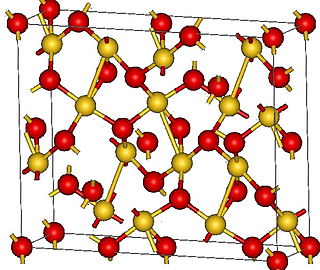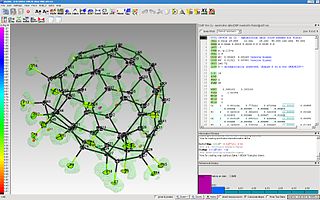Related Research Articles

X-ray crystallography is the experimental science of determining the atomic and molecular structure of a crystal, in which the crystalline structure causes a beam of incident X-rays to diffract in specific directions. By measuring the angles and intensities of the X-ray diffraction, a crystallographer can produce a three-dimensional picture of the density of electrons within the crystal and the positions of the atoms, as well as their chemical bonds, crystallographic disorder, and other information.

Manfred Eigen was a German biophysical chemist who won the 1967 Nobel Prize in Chemistry for work on measuring fast chemical reactions.

Sir William Lawrence Bragg, was an Australian-born British physicist and X-ray crystallographer, discoverer (1912) of Bragg's law of X-ray diffraction, which is basic for the determination of crystal structure. He was joint recipient of the Nobel Prize in Physics in 1915, "For their services in the analysis of crystal structure by means of X-rays"; an important step in the development of X-ray crystallography.

Sir Geoffrey Wilkinson FRS was a Nobel laureate English chemist who pioneered inorganic chemistry and homogeneous transition metal catalysis.
Hans Charles Freeman AM, FAA was a German-born Australian bioinorganic chemist, protein crystallographer, and professor of inorganic chemistry who spent most of his academic career at the University of Sydney. His best known contributions to chemistry were his work explaining the unusual structural, electrochemical, and spectroscopic properties of blue copper proteins, particularly plastocyanin. He also introduced protein crystallography to Australia and was a strong advocate for courses to ensure Australian scientists have good access to "big science" facilities. Freeman has received numerous honours, including being elected a Fellow of the Australian Academy of Science (FAA) and appointed a Member of the Order of Australia (AM) by the Australian Government. He was a charismatic lecturer who voluntarily continued teaching well into his formal retirement and imbued his students with a love of science.

Malcolm Leslie Hodder Green was Professor of Inorganic Chemistry at the University of Oxford. He made many contributions to organometallic chemistry.
Multi-wavelength anomalous diffraction is a technique used in X-ray crystallography that facilitates the determination of the three-dimensional structure of biological macromolecules via solution of the phase problem.

Gold(III) oxide (Au2O3) is an inorganic compound of gold and oxygen with the formula Au2O3. It is a red-brown solid that decomposes at 298 °C.

Francis Gordon Albert Stone CBE, FRS, FRSC, always known as Gordon, was a British chemist who was a prolific and decorated scholar. He specialized in the synthesis of main group and transition metal organometallic compounds. He was the author of more than 900 academic publications resulting in an h-index of 72 in 2011.

Sir Anthony Kevin Cheetham is a British materials scientist. From 2012 to 2017 he was Vice-President and Treasurer of the Royal Society.

Norman Neill Greenwood FRS CChem FRSC was an Australian-British chemist and Emeritus Professor at the University of Leeds. Together with Alan Earnshaw, he wrote the textbook Chemistry of the Elements, first published in 1984.

The Journal of Applied Crystallography is a peer-reviewed scientific journal published by Wiley-Blackwell on behalf of the International Union of Crystallography. It was established in 1968 with André Guinier as the founding editor. The journal covers the application of crystallography and crystallographic techniques. William Parrish (1914–1991) chaired the committee that started the journal.

The program ShelXle is a graphical user interface for the structure refinement program SHELXL. ShelXle combines an editor with syntax highlighting for the SHELXL-associated .ins (input) and .res (output) files with an interactive graphical display for visualization of a three-dimensional structure including the electron density (Fo) and difference density (Fo-Fc) maps.
Matthew Jonathan Rosseinsky FRS is Professor of Inorganic Chemistry at the University of Liverpool. He was awarded the Hughes Medal in 2011 "for his influential discoveries in the synthetic chemistry of solid state electronic materials and novel microporous structures."
Bernard Leslie Shaw, FRS was an English chemist who made notable contributions to organometallic chemistry. He was Professor of Inorganic and Structural Chemistry at the University of Leeds.

The Disordered Structure Refinement program (DSR), written by Daniel Kratzert, is designed to simplify the modeling of molecular disorder in crystal structures using SHELXL by George M. Sheldrick. It has a database of approximately 120 standard solvent molecules and molecular moieties. These can be inserted into the crystal structure with little effort, while at the same time chemically meaningful binding and angular restraints are set. DSR was developed because the previous description of disorder in crystal structures with SHELXL was very lengthy and error-prone. Instead of editing large text files manually and defining restraints manually, this process is automated with DSR.
Arndt Simon is a German inorganic chemist. He was a director at the Max Planck Institute for Solid State Research in Stuttgart.
John R. Helliwell is a British crystallographer known for his pioneering work in the use of synchrotron radiation in macromolecular crystallography.
Alexander Frank Wells, or A. F. Wells, was a British chemist and crystallographer. He is known for his work on structural inorganic chemistry, which includes the description and classification of structural motifs, such as the polyhedral coordination environments, in crystals obtained from X-ray crystallography. His work is summarized in a classic reference book, Structural inorganic chemistry, first appeared in 1945 and has since gone through five editions. In addition, his work on crystal structures in terms of nets have been important and inspirational for the field of metal-organic frameworks and related materials.

Gunnar Hägg was a Swedish chemist and crystallographer.
References
- 1 2 3 4 5 6 "CV" (PDF). Archived from the original (PDF) on 17 November 2015. Retrieved 15 November 2015.
- ↑ "Google Scholar: George M. Sheldrick". Archived from the original on 29 April 2016. Retrieved 15 November 2015.
- ↑ "70th Birthday: George Sheldrick". ChemistryViews.org. 17 November 2012. Retrieved 15 November 2015.
- ↑ Sheldrick, George M. (21 December 2007). "A short history of SHELX". Acta Crystallographica Section A. 64 (1): 112–122. doi: 10.1107/S0108767307043930 . PMID 18156677.
- ↑ "The SHELX homepage" . Retrieved 15 November 2015.
- ↑ Hübschle, Christian B.; Sheldrick, George M.; Dittrich, Birger (12 November 2011). "ShelXle: a Qt graphical user interface for SHELX". Journal of Applied Crystallography. 44 (6): 1281–1284. Bibcode:2011JApCr..44.1281H. CiteSeerX 10.1.1.287.2459 . doi:10.1107/S0021889811043202. PMC 3246833 . PMID 22477785.
- ↑ Seidel, Rüdiger W. (April 2015). "William S. Sheldrick (1945–2015)". Zeitschrift für anorganische und allgemeine Chemie. 641 (5): 750. doi: 10.1002/zaac.201510005 .
